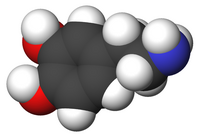
Photo from wikipedia
Dear Editor, The article in the February 2018 issue of CNS Spectrums titled “Mechanism of action of vesicular monoamine transporter 2 (VMAT2) inhibitors in tardive dyskinesia” has thoroughly elucidated the… Click to show full abstract
Dear Editor, The article in the February 2018 issue of CNS Spectrums titled “Mechanism of action of vesicular monoamine transporter 2 (VMAT2) inhibitors in tardive dyskinesia” has thoroughly elucidated the mechanism of dysfunction in tardive dyskinesia (TD) and illustrated the latest treatments for TD with novel drugs like valbenazine and deutetrabenazine. However, the author did not address the bigger picture or the possibility of using these drugs off-label to treat other disorders with similar dysfunction such as supersensitivity psychosis. In 2017 the FDA approved the first treatments for TD. The newly approved drugs are a highly selective vesicular monoamine transporter 2 inhibitors valbenazine (Ingrezza, Neurocrine Biosciences) and deutetrabenazine (Austedo, Teva). TD is thought to result from neostriatal dopaminergic receptor supersensitivity induced by protracted treatment with neuroleptics, or as Dr. Stahl describes it, as imbalance in “stop” and “go” signals from the motor striatum. Interestingly, in the 1970s 2 physicians at McGill University, Chouinard and Jones, suggested that dopaminergic receptor supersensitvity also occurs in the mesolimbic region after chronic neuroleptic exposure, resulting in the development of what they called “supersensitivity psychosis,” leading toward psychotic relapse by more than just the course of the normal illness. Furthermore, a 2012 study by Fallon, Dursun, and Deaken used a checklist of diagnostic criteria for supersensitivity psychosis and found it present in 39% of relapses. Relapse is a significant issue that plagues every patient. It has been estimated that for people with schizophrenia there is 40% relapse rate on medication in the first year following discharge from hospital; therefore identifying the causes of relapse is critical, as it impacts the option of treatment. Moreover, this iatrogenic “supersensitivity psychosis” hypothesis leads us to ask the following questions: Is there a correlation between neostriatal dopaminergic receptor supersensitivity and mesolimbic DA postsynaptic supersensitivity leading to tardive psychosis? Could dopaminergic pathways become permanently dysfunctional and entrapped in a hyperactive state as a result of persistent use of antipsychotics? Could a treatment for TD be effective for supersensitivity psychosis as well? More research is needed to answer these important and complicated questions. Furthermore, supersensitivity psychosis is an extremely important concept for today’s prescriber due to the overuse of neuroleptics as a panacea in children and adults. This hypothesis should be revisited and honestly discussed in the psychiatric community regardless of the concerns about political correctness in regard to drugs and the pharmaceutical companies. Therefore, understanding the supersensitivity mechanism and its treatment is essential to provide our patients with better outcome. In conclusion, the approval of the VMAT2 inhibitors valbenazine and deutetrabenazine for TD, combined with the high level of relapse triggered by long-term use of antipsychotics, as well as the apparent correlation between DA receptor supersensitivity in the mesolimbic and neostriatal regions, should motivate researchers to conduct a thorough study of valbenazine’s and deutetrabenazine’s efficacy (off-label) as single agents in the treatment of supersensitivity psychosis. By selectively reducing the ability of VMAT2 to load dopamine into synaptic vesicles, the drug reduces overall levels of available dopamine in the synaptic cleft, hypothetically mitigating the symptoms associated with dopamine hypersensitivity in the neostriatal and mesolimbic regions, thus targeting 2 birds with 1 effective stone. * Address for correspondence: Richard Skaff, MA, MS, PsyD, PO Box 2782, Palos Verdes Peninsula, CA 90274, USA. (Email: [email protected]) doi:10.1017/S1092852918001116
Journal Title: CNS Spectrums
Year Published: 2018
Link to full text (if available)
Share on Social Media: Sign Up to like & get
recommendations!